
What is Equine-Assisted Therapy?
As the Executive Director and therapist at Rusty Halo Ranch, I am a certified provider of Equine-Assisted Therapy. But just what is that?
Equine-Assisted Therapies are mental-health services that support clients by getting in touch with themselves, using horses’ acute sensitivity to their environments — including the feelings of people around them — along with people’s natural tendency to emotionally bond with the animals.
Horses are prey animals, always instinctually aware of their surroundings for their own protection. In turn, people tend to become quickly attuned to horses. The presence of a horse — which never judges a person — can create a “safe space” to start exploring feelings. Clients can start to tell their own stories, noticing things they may not have realized before. The client and I can watch the reaction of the horse, and the client’s reaction to that, providing opportunities to reflect and learn. For example, if a horse becomes skittish and runs away to hide, a client might become aware of a tough feeling, acknowledge that feeling, and start to work on it.
Horses don’t carry baggage or follow social conventions; they are just with you, reacting in the moment. This can make it easier to learn from a horse’s reaction to what’s going on with the client. A horse can’t tell secrets; doesn’t care how you are dressed; accepts you just as you are.
How does this become therapy?
When a horse brings out something difficult in a client, a licensed and certified therapist who is trained and skilled at providing trauma-informed care knows how to handle it in a way that is helpful and doesn’t do harm to the client. For example, we’ve seen in working with youth in the foster system that horses bring out tremendous, complex traumas. A therapist needs to know the stages of trauma to work at a pace the client is ready to handle — how to process the issues that come up so the client can move forward, and what types of interventions are most suitable at any given time. These crucial support structures provide thoughtful, trauma-informed care, ensuring the psychological safety of the client.
How fast does it work?
The process of equine therapy is a little different than other methods. We often get quick results through a slower process.
What does that mean?
I follow the social-work model of meeting clients where they are and letting them take the lead. Maintaining a pace that doesn’t make the client feel “pushed” is crucial, especially when working with trauma. It’s important to let the client’s nervous system set the tone, allowing the client time to process, and to not move beyond what the client is ready to handle. This is especially beneficial with clients on the autism spectrum, who often achieve remarkable results in this kind of work. Spending plenty of time laying the groundwork often pays off in significant improvement over a shorter period of time than with traditional office-based “talk therapy.”
Other therapeutic methods
Not everyone is comfortable interacting with horses, especially at first. With some clients, we start by sitting in the pasture watching the horses, or even doing artwork. Being trained in a variety of evidence-based therapeutic methods gives me a wide menu of options, and I have a good sense of what will work best with a given client. Just being out in nature, sitting around a fire pit or watching squirrels in the trees, can enhance the therapeutic experience.
Whether you’ve had frustrating results with traditional office-based “talk therapy” or simply are attracted to the idea of working in this way, with attentive animals in a natural outdoorsy space, I invite you to get in touch to discuss how the therapeutic offerings of Rusty Halo Ranch can work for you.
Equine Therapy FAQs
-
Closed toed shoes are important for the safety of your feet. For clothing, if you can wear layers appropriate for the weather that can get dirty it will enhance the experience. Bring water and an openness to learn and grow!
-
Every session is unique to the individual and what they are experiencing in the moment. We typically do a 50 minute session with a horse, or multiple horses, starting on the the ground. There is typically no riding, most of the work is done with humans having two feet on the ground. If riding is deemed important to the work, that will be decided by the clinician and client as they built out a treatment plan. The experience may leave you tired. Please exercise self care and allow yourself some time outside of sessions for rest and reflection.
-
As horse care and barn life can be expensive, this type of therapy does cost more than traditional types of therapies. We work to keep our costs achievable so many can experience the benefit of an outdoor setting and be with the horses to hopefully feel healing. During your consultation the fees will be reviewed. We have set up ways to help offset costs for those that may need assistance, such as a sliding scale as appropriate. There is also an opportunity to apply for assistance through our nonprofit partner, Rusty Halo Foundation, if you are 13 to 23 years old and have experienced system use.
-
In the spirit of meeting our clients where they are at, if working with horses is not what is best, we are fortunate to be able to offer other methods of therapies that can all be experienced at a barn. As the horses live in the space, they will be present, however, you do not have to work with a horse.

